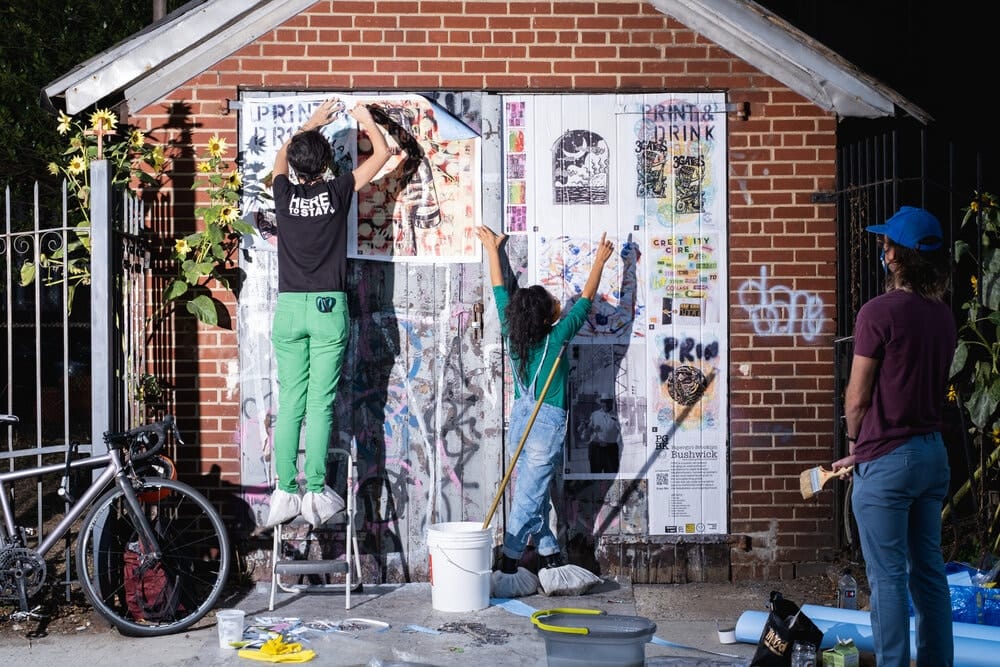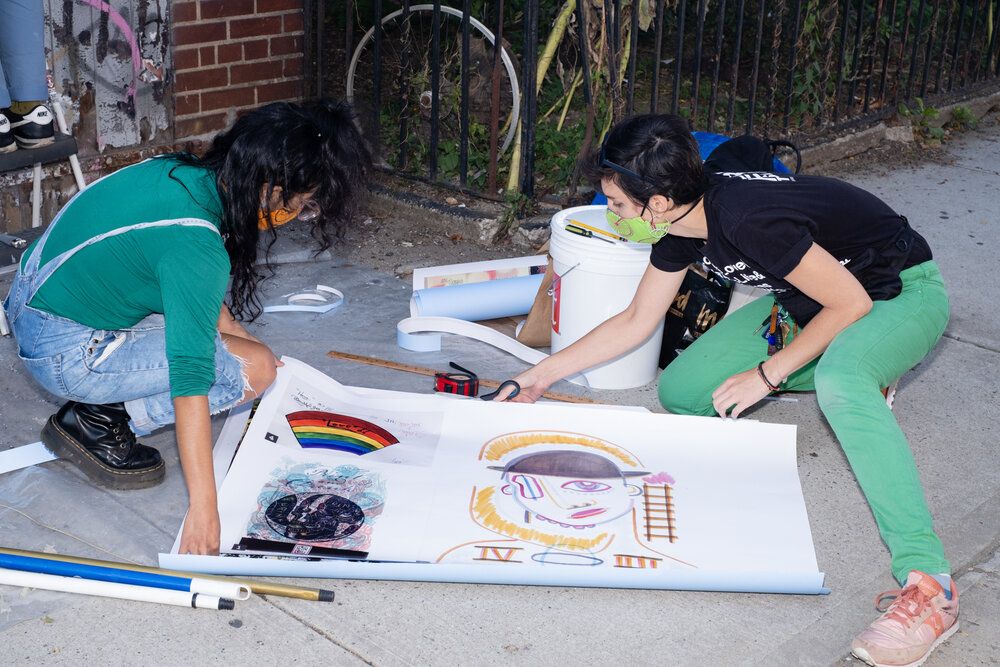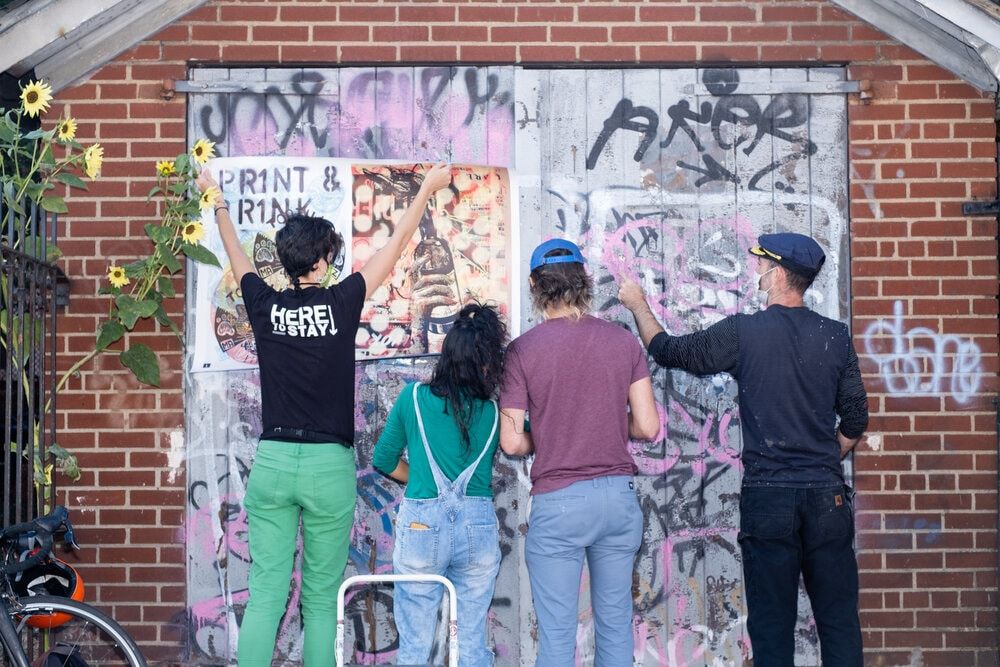Papergirl-Brooklyn’s Location Specific Interactive Exhibits Contemplate Art And Community Across Eight Neighborhoods


The team behind Papergirl-Brooklyn, an interactive art project currently on display in six Brooklyn neighborhoods, believe that art needs to be more accessible. The project brings together work by 80 artists from ten countries. The art is pasted together to form a series of massive murals dotted throughout Brooklyn, visible – and completely free – to anyone who chooses to visit them.
Launched by Brooklyn artist and organizer Sina Basila Hickey, Papergirl-Brooklyn is an adaptation of the original Papergirl, an open-sourced project begun by Berlin artist Aisha Ronniger in 2006. Hickey, born in the southwest of Germany and raised in the U.S., got involved with Papergirl while living in Berlin as an adult. It was when she was in school in the states, however, that she began her career as an activist, advocating for labor rights. Art, she found out, could be a potent political tool. Papergirl, available to anyone and everyone, provided an ideal platform.
Hickey explains that “we feel that everyone should have access to art, and it shouldn’t just be available to those with means, or just be available in galleries and museums.” She and the Papergirl-Brooklyn team had to adapt the project to work within COVID-19 restrictions. But these restrictions ultimately strengthened the project, Hickey feels. “We were able to make it available in more places, and hopefully reach different types of audiences.”
An audio program accompanies each installation and brings it to life through conversations between two Brooklyn artists, at least one of whom is from the neighborhood itself. The hope is to help the viewer engage with the art and understand the people who live there and the issues they face – not least of which is gentrification. Art, Hickey told us, can itself play a role in gentrifying a neighborhood.

“What I think every artist needs to contemplate is just, by bringing something to these different neighborhoods where you don’t actually have your own roots, there’s positive and negative things that come from it,” said Hickey. “We were really interested in looking at the places that nourished and grew these areas to the reasons they are valuable to people, the reason that they are attractive.”
Hickey and her partner on the project, artist and teacher Annie Del Hierro, centered these people not only by including the voices of local artists, but by bringing in music that represents the neighborhood and by promoting local businesses.
“We want to give some identity to every location,” explained Del Hierro.
In the recording for the Flatbush (Ditmas Park) installation, artist and Flatbush resident Carlos Pinto says that “since 20 years ago, I [found] out the real estate development is using public art as an instrument of gentrification. And I didn’t want to play that role.”
Public art, Pinto and fellow artist Vince Ballentine agree, can be used to beautify a neighborhood, but it should also reflect that neighborhood’s identity, not just the artist’s vision.
“Especially painting little black kids,” said Ballentine. “A lot of these kids aren’t subject to seeing these things on a regular basis. So for them to see a 12-foot giant little black kid is kind of inspiring – especially when, in so many facets of life, they don’t ever see themselves represented to that magnitude.”
A few other Brooklyn artists and organizations in the audio program include Bushwick’s MayDay Space, Betty Yu, Aranxta Araujo, and the founders of East New York’s Universe City.

Other social and political issues broached in the various installations include immigration, food insecurity, and identity. One piece in particular, Del Hierro said, centers on the issue of incarceration.
“We asked [the artist] to send us her voice memo with her statement. And it’s such a powerful thing to hear. That’s the impact that the artist can [create].”
Del Hierro, who immigrated to Brooklyn from Quito, Ecuador, also sees art as something that can help people understand the realities and struggles of immigrants.
“There are people who move to America that [don’t] have the facility of learning the language. And it’s not easy.”
The installations are scattered throughout the borough representing a diverse cross-section of Brooklyn neighborhoods. The sites currently available to view include Coney Island, Flatbush, Bushwick, Greenpoint, Sunset Park, and Brownsville/East New York, with sites in Bed-Stuy and Red Hook soon to come.
On an “undisclosed date” the original pieces (the works are made into prints and affixed with wheat paste to the walls) will be rolled up and handed out, at random, to people on the street – adding another layer to the project’s mission of democratizing art, Hickey explained.
“Art is very precious. But there’s also this trust in that person. They have agency now over the art – you’ve given it to them unconditionally, rather than saying ‘you can only have it if you’re going to frame it’ or something.”
The installations’ addresses and more information on the project can be found on the Papergirl-Brooklyn website.



